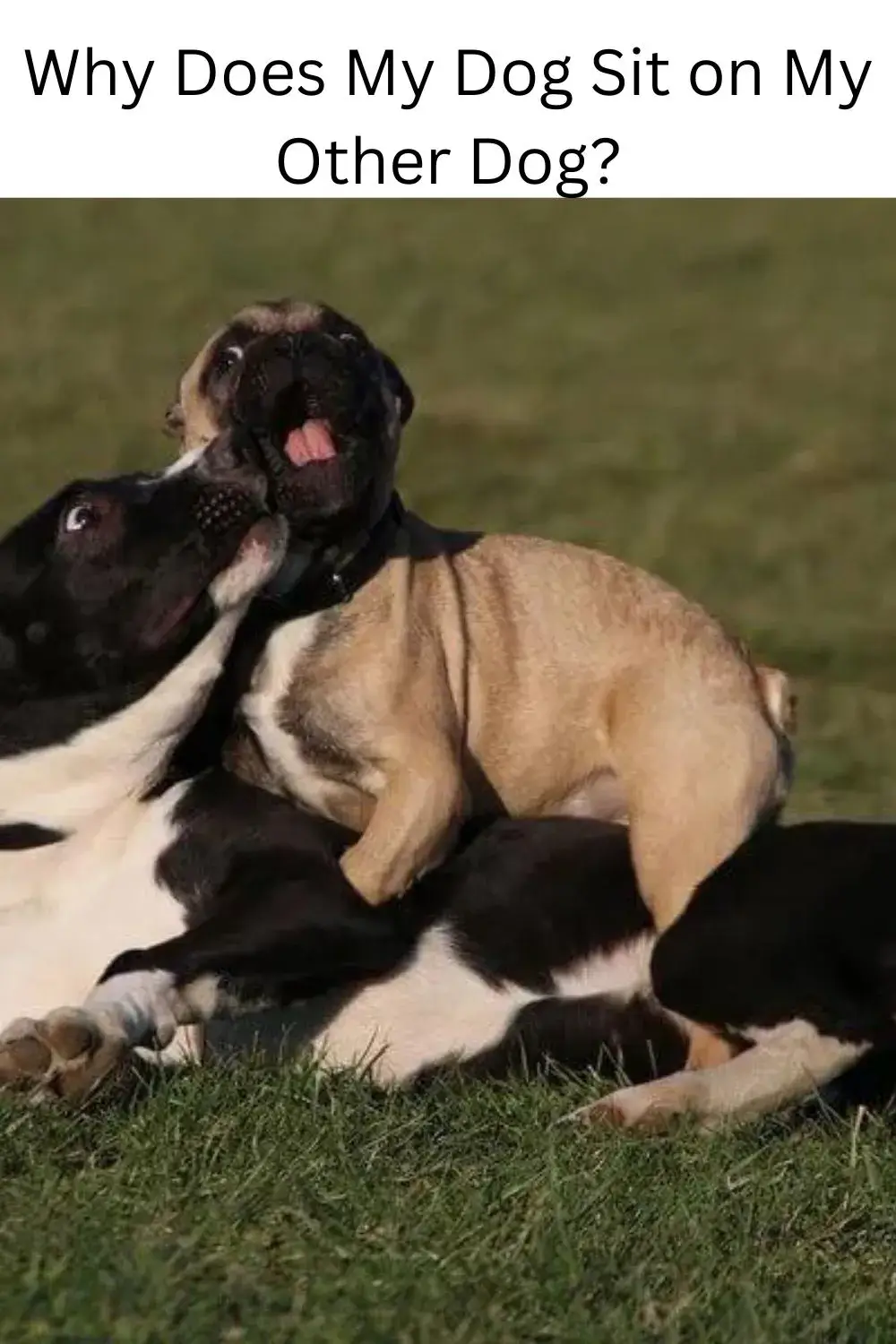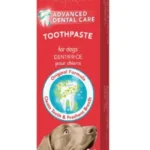‘Why does my dog sit on my other dog?’ Well, you’re far from alone. I remember the first time I spotted my friend’s Bulldog, Benny, casually plonking himself down on their Beagle- Bella. Is Benny just being a bit goof, or is there more to it than meets the eye? As it turns out, dogs have a complex social dynamic, including a pack hierarchy that can seem shocking. A dog sitting on another dog could be a sign of asserting dominance or a display of submission, depending on the context.
So, ‘What does it mean when one dog sits on another?’ or ‘How do dogs show dominance against other dogs?’ or even ‘Why does my dog lean on my other dog?’ You will get answers to these questions shortly. First, let’s dig into the delightful world of canine social dynamics and uncover their secret doggy language.
Why Does My Dog Sit on My Other Dog?
Let’s explore the fascinating reasons behind the question bugging many of us: “Why does my dog sit on my other dog?”.
Dominance
This might be the first explanation that comes to mind. Yes, in many instances, this behavior can be a subtle way of asserting dominance, especially among younger or assertive dogs. Think of it as saying, “I’m the boss here!”.
Dogs have a pack hierarchy; one way they demonstrate this is by sitting on each other. This is a non-aggressive way of saying, “I’m in charge.” A study conducted by the Journal of Ethology supports this claim, stating that higher-ranking dogs tend to influence the behaviors of lower-ranking dogs.
Solution
If your dog displays this behavior as a sign of dominance, it’s essential to manage it correctly. While it might seem harmless initially, it can lead to aggressiveness if left unattended. Encouraging healthy playtimes and rewarding good behavior can help manage this dominance issue.
Warmth and Comfort
This explanation leans more on the adorable side. Dogs instinctively huddle together for warmth and comfort, especially during colder months. So, if you notice your boxer sitting on your other dog during winter, it might just be seeking some warmth.
Solution
To prevent this, ensure that your dogs have their own comfortable and warm sleeping areas to prevent one from seeking warmth from the other.
Play and Incitement
When one dog sits on another, it’s often an invitation to play. This act can be playful, like teasing or initiating wrestling games. It’s different from when children play and tumble over each other.
Solution
If this is the case, there’s nothing much to prevent or correct. Just make sure the play remains friendly and doesn’t escalate into aggression.
Attention Seeking
Attention-seeking might be the answer if you’ve ever asked, “Why does my dog sit on me and not my husband?”. By sitting on another dog, your pet may try to grab your attention, especially if they feel neglected. It’s their way of saying, “Look at me!”
Solution
To manage this behavior, ensure that you provide equal attention to all your pets. Regular playtimes and interaction go a long way in making your dog feel loved and attended to.
In understanding why one dog sits on another, you are decoding a part of the secret doggy language, helping you better understand and manage your dogs. While some behaviors can be prevented or corrected, others are harmless and part of your dog’s unique character.
Interpreting Your Dogs’ Behavior
One of the key aspects to understanding ‘Why does my dog sit on my other dog?’ is observing their body language and the context in which it happens. Does your dog sit on your other dog during cold or playtime? Or does your dog lean on your other dog when you’re not around? The answers to these questions can provide valuable insights into their behavior.
Observation is key when it comes to interpreting canine behavior. Take note of their body language – are their tails wagging, are they showing their teeth, or are they growling? These cues can help determine whether they’re playful, dominant, or submissive.
To address a different question, ‘Where does the alpha dog sleep?’, the alpha dog may choose a prime spot to showcase their dominance. If it’s a matter of submission, as in ‘How do dogs show submission to each other?’ or ‘How do dogs show submission to other dogs?’, a submissive dog might let the dominant dog sit on it without showing signs of stress or displeasure.
Here’s a brief table summarizing body language cues for different behaviors:
| Behavior | Body Language Cues |
| Dominance | The dog on top may hold its tail high, have a stiff posture, and direct eye contact. |
| Comfort | Dogs may be relaxed, eyes half closed, body loose. |
| Play | Fast wagging tail, playful bowing, light barks or growls |
| Submission | The dog on the bottom may avoid eye contact, show belly, and keep its tail between its legs. |
Keep these cues in mind next time you’re wondering, ‘Why does my dog sit on me and not my husband?’ or ‘How do dogs show dominance against other dogs?’. Happy dog-watching!
Addressing Concerns and Tips for Harmonious Dog Interactions

If dominance or aggression seems to be the underlying factor that makes you wonder, “Why does my boxer sit on my other dog?” gentle redirection techniques can be effective. For instance, when you notice the dominant dog trying to sit on the other, distract them with a toy or a command, thus promoting respectful interactions. Training classes can also be beneficial in curbing aggressive behavior.
Providing enough individual attention and playtime for all dogs is vital, too. Attention can help avoid jealousy or competition that may lead to the puzzling situation of “Why does my dog sit on me and not my husband?”. You can foster a harmonious pack environment by ensuring each dog feels loved and attended to.
Positive reinforcement is a powerful tool for encouraging desired behavior. If you’re observing submission behaviors and wondering, “How do dogs show submission to each other?” rewarding the submissive dog when it stands its ground can help build confidence. Similarly, if you’re tackling dominance issues and asking, “How do dogs show dominance against other dogs?” rewarding good behavior such as respectful play can promote balance.
Remember, your goal is to create a home where each dog feels relaxed, valued, and secure. Regularly spending quality time with each dog, maintaining consistency in rules, and understanding their unique personalities will go a long way in achieving this. So, next time you question, “Why does my dog sit on my other dog?” you’ll have the tools to handle it confidently.
Embracing the Unique Bond and Dynamics of a Multi-Dog Household
In wrapping up, we’ve discovered that the question, “Why does my dog sit on my other dog?” can have multiple answers. It could be a playful gesture, a dominance display, or even a sign of seeking comfort. Similarly, when we ask, “What does it mean when one dog sits on another?” the answer can be found by observing the dogs’ body language in the given context.
The unique dynamics between your dogs, whether your boxer is sitting on your other dog or your dog leaning on its sibling, are part of the wonderful world of doggy relationships. Even when you’re left asking, “Why does my dog sit on me and not my husband?” or “Where does the alpha dog sleep?” remember that every action tells a story of their unique personalities and relationships.
By understanding these nuances, you can better manage behaviors, whether about dominance, submission, or comfort-seeking. Understanding whether your dogs show dominance or submission to each other allows you to ensure a balanced and happy home.
In the end, the joy of a multi-dog household lies in embracing these unique behaviors and bonds. So the next time you wonder, “Why does my dog sit on my other dog?” let a smile cross your face as you try to understand the fascinating lives of your furry friends.





